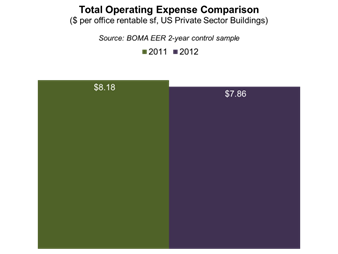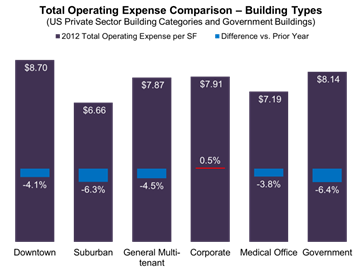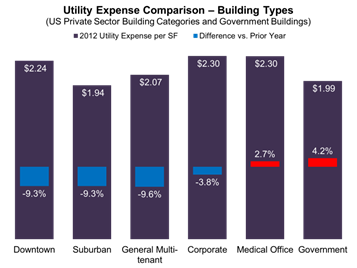According to a study of data from the Building Owners and Managers Association (BOMA) International’s Experience Exchange Report (EER) by Kingsley Associates, the commercial real estate industry’s ongoing focus on energy efficiency has resulted in a downward trend in total operating expenses.
Analysis reveals that properties in the United States reduced total operating expenses from $8.18 to $7.86 per square foot (psf) on average from 2011 to 2012, a difference of $0.32 or 3.9 percent. About two-thirds of these savings were achieved in the utility category, where average expenses fell $0.21—a whopping 9.0 percent—to $2.12 psf, underscoring an industry focus on maximizing building efficiency and smart asset management.
Nearly all building types boasted operating expense savings during 2012. Only corporate facilities saw total operating expenses remain essentially unchanged with a slight 0.5 percent increase. Downtown buildings remained, on average, more expensive to operate than their suburban counterparts, and they also reported a slightly smaller expense savings (4.1 percent versus 6.4 percent for suburban buildings).
As with total operating expenses, the decrease in utility expenses per square foot in 2012 also was broad-based. Private sector office buildings in both downtown and suburban locations observed an identical 9.3 percent reduction, though costs remain higher at downtown locations. Multi-tenanted buildings were able to achieve greater savings than corporate or single-tenanted facilities (9.6 percent versus 3.8 percent), but the trend was the same for both. However, not all property types saw a decline in this area. Utility costs rose 2.7 percent at medical office buildings and 4.2 percent at government-occupied facilities.
In addition to substantial savings on utilities, analysis also revealed that private sector office buildings spent $0.06 (4.0 percent) less per square foot on cleaning in 2012. Cleaning and administrative expenses are essentially tied as the third largest expense categories, behind utilities and repairs/maintenance. Building owners and managers were also able to make modest cuts in security and roads/grounds expenses (a $0.03 decrease in each category), though these categories are small relative to others.
These findings are based on an examination of a specialized control sample of more than 2,000 private sector buildings representing 385 million rentable square feet of U.S. office space that submitted both 2011 and 2012 expense data to the EER database. The sample only includes buildings meeting certain criteria in order to control for the impact of major renovations and changes in occupancy on operating expenses to ensure trends captured are representative of market reality. A complete analysis can be found in the latest issue of The BOMA Magazine.
With detailed income and expense information from more than 5,300 buildings across more than 250 markets, BOMA International’s Experience Exchange Report (EER) is commercial real estate’s premier income and expense benchmarking tool with the largest and most accurate data available in the industry. The EER allows users to conduct multi-year analysis of single markets and select multiple cities to generate state and regional reports. It also offers the capability to search by market, submarket, building size, building type and more for broader analysis. The 2013 Experience Exchange Report is available now at www.bomaeer.com.
About BOMA International
The Building Owners and Managers Association (BOMA) International is a federation of 93 BOMA U.S. associations, BOMA Canada and its 11 regional associations and 13 BOMA international affiliates. Founded in 1907, BOMA represents the owners and managers of all commercial property types, including nearly 10 billion square feet of U.S. office space that supports 3.7 million jobs and contributes $205 billion to the U.S. GDP. Its mission is to advance the interests of the entire commercial real estate industry through advocacy, education, research, standards and information. Find BOMA online at www.boma.org.
About Kingsley Associates
The most successful firms in real estate rely on Kingsley Associates for cutting-edge business intelligence solutions. With a depth and breadth of insight unmatched in the industry, Kingsley Associates brings thought leadership and passionate client service to every engagement. Kingsley Associates is a leader in tenant satisfaction surveys, resident satisfaction surveys, client perception studies, strategic consulting and operations benchmarking. To learn more, please visit our website at www.kingsleyassociates.com or our blog at www.kingsleyinsight.com.
Related Stories
| Aug 11, 2010
Report: Fraud levels fall for construction industry, but companies still losing $6.4 million on average
The global construction, engineering and infrastructure industry saw a significant decline in fraud activity with companies losing an average of $6.4 million over the last three years, according to the latest edition of the Kroll Annual Global Fraud Report, released today at the Association of Corporate Counsel’s 2009 Annual Meeting in Boston. This new figure represents less than half of last year’s amount of $14.2 million.
| Aug 11, 2010
Davis Langdon, DEGW merge
Leading global construction consultancy Davis Langdon and strategic planning consultants DEGW have announced a merger
| Aug 11, 2010
Peter Marchetto joins Tishman as president of Construction Operations
Tishman Construction Corporation Chairman, Daniel R. Tishman, today announced that Peter Marchetto joined the company as President of Construction Operations.
| Aug 11, 2010
Jacobs, HDR top BD+C's ranking of the nation's 100 largest institutional building design firms
A ranking of the Top 100 Institutional Design Firms based on Building Design+Construction's 2009 Giants 300 survey. For more Giants 300 rankings, visit http://www.BDCnetwork.com/Giants
| Aug 11, 2010
Polshek Partnership unveils design for University of North Texas business building
New York-based architect Polshek Partnership today unveiled its design scheme for the $70 million Business Leadership Building at the University of North Texas in Denton. Designed to provide UNT’s 5,400-plus business majors the highest level of academic instruction and professional training, the 180,000-sf facility will include an open atrium, an internet café, and numerous study and tutoring rooms—all designed to help develop a spirit of collaboration and team-oriented focus.










